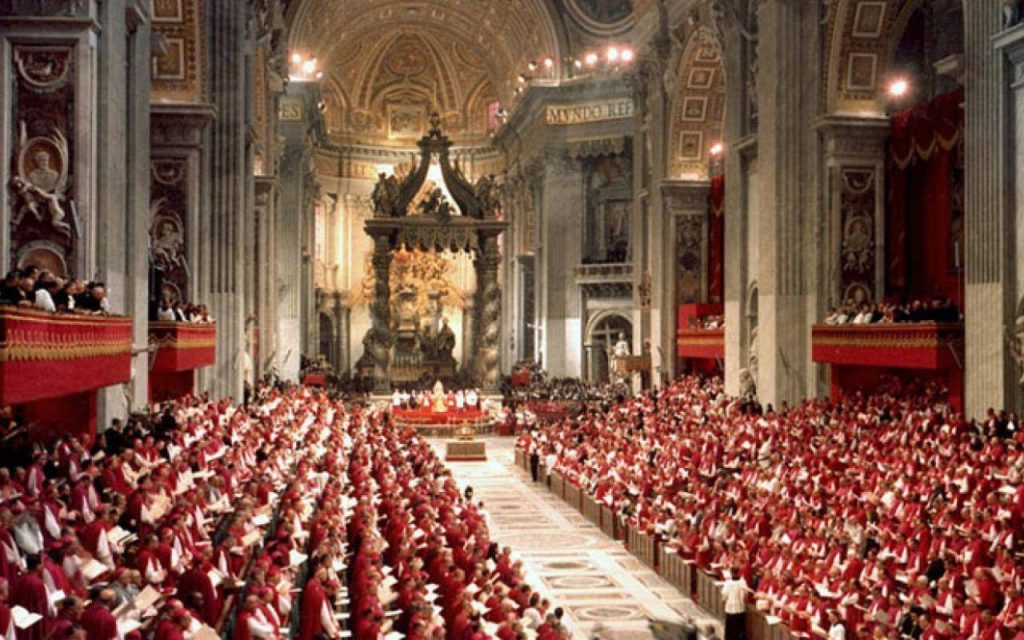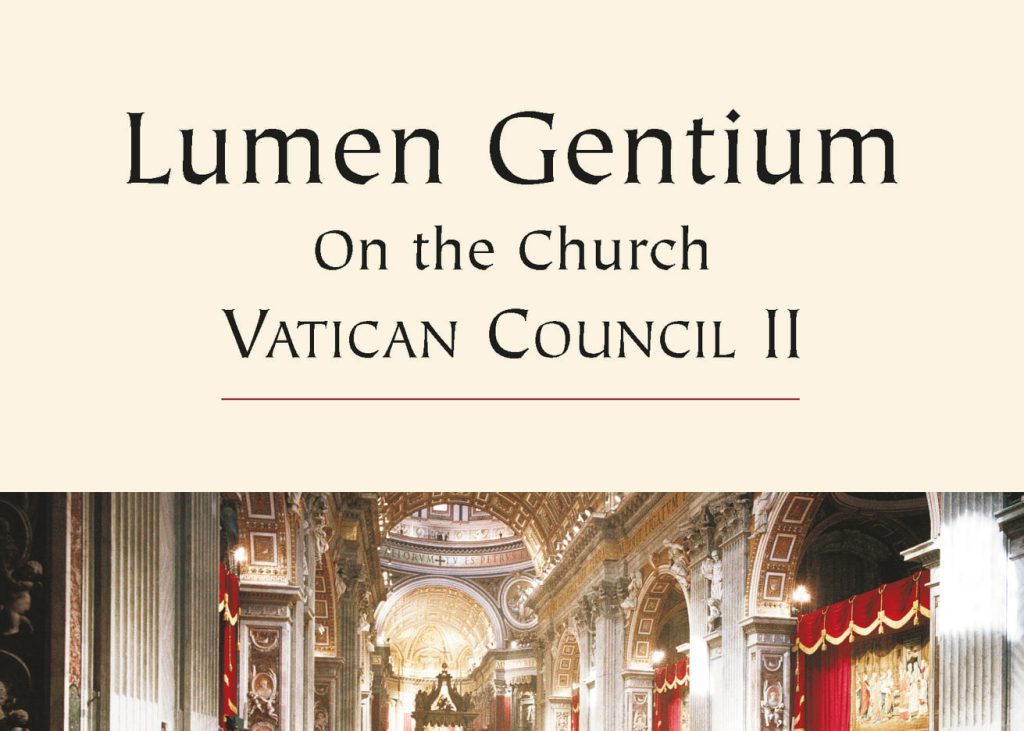When people are asked “where is the Church,” the automatic response is to point you to a building. Sometimes, they refer to the bishops, priests and sisters. Hardly will they say: “We are the Church” even if this is what Vatican II already said in 1965.
How do Catholic Christians look at themselves as a Church? The questions that probe into our communal self-understanding is found in the Vatican II document called “Lumen Gentium” (The Dogmatic Constitution of the Church).
The notion of the Church as a “people of God” is a happy development brought about by Vatican II. Even until today, ordinary people think of the church in terms of pyramids with the pope, bishops, and priests on top of the structures. The “hawak-kamay (holding hands)” image of all the members as one people called by God is a crucial concept introduced in Lumen Gentium (Chapter II) which, after 55 years, has not yet really been incarnated in the structures of our parishes or in the structures of our minds. I think we have been used to the pyramids for a long time. Or, some people still prefer to keep it that way. The Church has always been conceived of as a building structure, not as people.
One of the most applauded interventions during the Council came from Bishop Smedt of Belgium. He said that the first draft (Schema on the Church) was full of triumphalist, clericalist and juridical views. It used the old word “church militant” as if it is “lining up its members in battle array.” The Church is not a pyramid of people, priests and pope, he continues, that is “hierarcholatry” (Rynne 1963, 218).
But the Church has always been seen for centuries as a perfect and hierarchical society. Long before Vatican I, Gregory XVI (1765-1846) already said: “The Church is an unequal society in which God has destined some to command and others to obey. The latter are the laity, while the former are the clergy.”
The first draft “On the Church” echoes this same framework and some bishops wanted to shoot it down. Cardinal Frings was quite vehement. He made a famous speech on November 8, 1963, during the Council attacking the triumphalist workings of Roman Curia. Some people claim that Joseph Ratzinger, his theologian-consultant, was the writer of this speech (Dulles 2006). Henri de Lubac wrote: “It is not an exaggeration to say that on that day the Old Holy Office, as it presented itself then, was destroyed by Ratzinger in union with his archbishop” (De Lubac 2007, 123). After all the long debates, the final document showed something different: the Church is first of all a “People of God” (Chapter II); only then can we talk of the hierarchy (Chapter III).
For indeed Vatican II did not transform the Church into a “democratic society” (as it is conceived in Western societies in our time). It still continues to acknowledge its hierarchical structures. But these offices in the Church are ministries of service, not of power — of which the pope is the “servant of servants of God” (servus servorum Dei — this is his title in Latin).
The hierarchy should not be thought of as a structure of power but a structure to serve the world better. Lumen Gentium states: “For the nurturing and constant growth of the People of God,” Vatican II proclaims, “Christ the Lord instituted in His Church a variety of ministries, which work for the good of the whole body. For those ministers, who are endowed with sacred power, serve their brethren, so that all who are of the People of God, and therefore enjoy a true Christian dignity, working toward a common goal freely and in an orderly way, may arrive at salvation.” (LG 18).

After Vatican II, episcopal conferences, dioceses, parishes tried their best to implement this vision of the Church through different concrete structures on the ground: BECs, parish councils, presbyteral councils, coordinating bodies, etc.
But in 1985, Ratzinger revisited this central concept and this time found it quite ambivalent. He thinks that the metaphor “People of God” goes all the way back to the Old Testament. It needs to be complimented with a New Testament image — the Body of Christ — which he also prefers. For him, the “People of God” metaphor has become too political and sociological. It has been overly exploited by liberation theology making the Church a “purely human project” which can be religious in appearance but atheistic in substance. The “body of Christ,” in his mind, brings in the mystery and the supernatural dimension of the Church which makes the Church “not democratic but sacramental, consequently, hierarchical” (Ratzinger 1985, 47).
Truth to tell, the “Body of Christ” metaphor is also present in Lumen Gentium and harks back to Pope Pius XII’s “Mystici Corporis.” It recalls the Pauline image of the body with many members, all of which are equal regardless of its size or function. It reminds us of the equality of all members of the People of God. But Ratzinger’s dualistic rereading (body vs. people) brings ecclesiology back to a position to which the Council Fathers reacted from the start.
Crucial to the “People of God” metaphor in Lumen Gentium is the notion of collegiality among bishops. Lumen Gentium states: “Together with its head, the Supreme Pontiff, and never apart from him, it [college of bishops] is the subject of supreme and full authority over the universal church” (LG, 22). This collegiality is concretized in structures like the ecumenical councils, Synod of bishops, local councils, episcopal conferences, etc.
What is asserted is the fact that the bishops too are teachers of the faith in their own right — this time — when they are gathered as a college in union with the Pope. What this tries to correct is the problem of “papalism” — the centralization of the teaching office to the Pope alone executed for him by the Roman Curia. In one of those earlier reflections, Ratzinger wrote: “Catholicity no longer meant merely looking toward Rome; it also meant looking towards one’s neighbor” (Ratzinger 1966).
Pope Francis “dramatized” collegiality when on his election as pope in March 2013, he introduced himself as the “bishop of Rome.” Even as he is the pope, he wanted to say, he is a bishop like the rest of the bishops in the smallest dioceses of the world. He is conscious of the influence that he wields so he talks about the “conversion of the papacy”: “Since I am called to put into practice what I ask of others, I too must think about a conversion of the papacy. It is my duty, as the Bishop of Rome, to be open to suggestions which can help make the exercise of my ministry more faithful to [its] meaning… Excessive centralization, rather than proving helpful, complicates the Church’s life and her missionary outreach” (Evangelii Gaudium 32).

If we have to salvage the message of Lumen Gentium for our times, we need to recover the meaning of these related concepts at the heart of this famous document: “decentralization,” “accountability,” “transparency,” “co-responsibility,” and “subsidiarity” — values which the Church, bishops, priests and sisters pay lip service to.
Pope Francis talks about the notion of “synodality” (the theme for the next Synod in 2022). This also means the same: that we are a people of God and the body of Christ all in equal places around God’s table whoever we are — sinners and saints; clergy and laity; priests, religious and bishops; women, men and gays; rich and poor, young and old, etc. Joey Velasco’s painting of “Hapag ng Pag-asa (Table of Hope)” concretizes what this means: all have a place around Jesus; we equally share in our mission from God’s table.
But we know this is far from reality. Many of our pastoral leaders are still dictatorial and authoritarian — almost believing in the saying “ang utos ng pari ay hindi nababali (the priest’s command cannot be bent.” The old saying was: “ang utos ng hari (the king’s command).” The slide from “hari (king)” to “pari (priest)” is not just semantic; it is structural. “Ako ang kura paroko dito. Kaya sumunod kayo (I am the parish priest. You all follow me),” I heard one young priest say.
When asked whether they feel we are all equal within the Church community, many people would answer in the negative. An image to prove this is the banquet receptions after the fiesta Mass in our parishes: a few dignitaries stay in the presidential table; while the rest are given their “supot (packed lunch)” to eat under the mango tree.
Many priests do not immerse with their people; so they actually do not know what their people say. They do not ask them; there is no feedback mechanism that makes the center know the voices of the peripheries; or to use a corporate image, that makes the managers know the preferences of their clients.
Lay people do not find their rightful place in the decision-making structures of the Church, much more so the women. There are parishes that still do not have Parish Pastoral Councils and Finance Councils because the parish priests do not want to. These issues are the real enemies of equality, co-responsibility, accountability, transparency, and subsidiarity. If we demand accountability from the government, why not from the Church?
These are not mere personality defects or lack of skills from our leaders. These are structural flaws. What the Church and Church groups need are concrete and viable structures that make each one co-responsible and accountable. For instance, how many dioceses, parishes, congregations have working accounting structures? How transparent are these? With these structures, our leaders do not have to micro-manage because we are all accountable, not just the bishops and priests. They can trust us, thus, fostering subsidiarity in our levels. Without these structures, we are back to the centralist, triumphalist and authoritarian church.
However, it is not all bad news. There are also small flickers of hope sometime, somewhere. We need to work out for more.
I once gave a seminar for Basic Ecclesial Communities in one of the dioceses. There were around 3,000 people in attendance. When lunch time came, all lined up and got the same food, and sat down in whatever space they found. There was no presidential table, except for some little table provided for the elderly and PWD. I was late to join the line because some people came up for questions and, of course, selfies! The bishop waited for me, and we followed the same line. When we reached the distribution table, there was no more plate left. And the bishop picked up two kettle covers and gave one to me: “Wala nang plato, Father, takip na lang ng kaldero sa atin. Mas maganda ito. Mas maraming makakain natin (There is no more plates, Father, only the pot covers. This is good. We can eat more).”
Another instance, in one priests’ assembly, a bishop told his priests: “I know that the Canon Law says that your Pastoral Councils are only consultative. It also says that as parish priests, you have the last say. But I tell you: please do not invoke it. How can you empower them if you do not trust them?”
I silently told myself: “This is Lumen Gentium at work on the ground.”
Father Daniel Franklin Pilario, C.M. is a theologian, professor, and pastor of an urban poor community in the outskirts of the Philippine capital. He is also Vincentian Chair for Social Justice at St. John’s University in New York.









